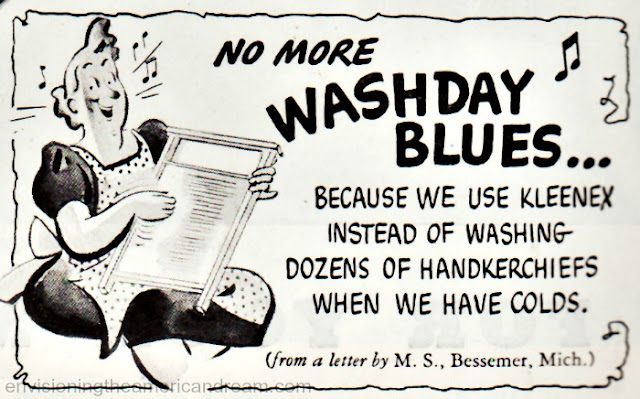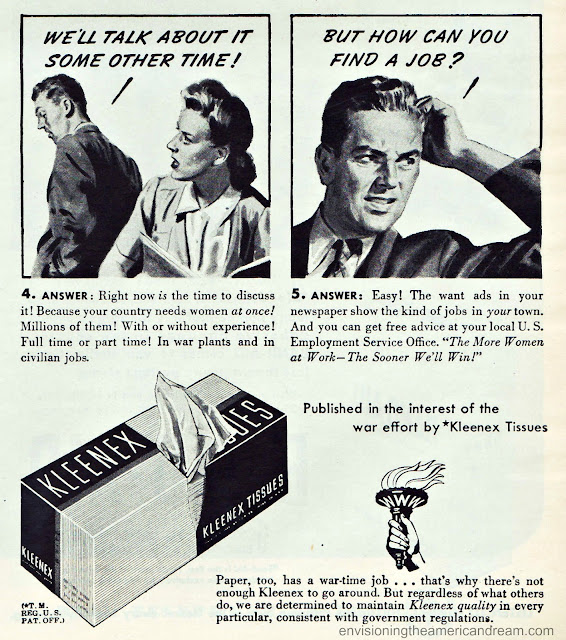________________
|
What
is it:
Kleenex is
a brand name for a variety of paper-based products such as facial tissue,
bathroom tissue, paper towels, tampons, and nappies (diapers, for US
readers). Often used informally as a
genericized trademark for facial tissue in the United States, the name
Kleenex is a registered trademark of Kimberly-Clark Worldwide, Inc.
|
|
Origin:
Kimberly, Clark and Co. was founded in
1872 in Wisconsin. The group's first
business was operating paper mills, which the collective expanded throughout
the following decades. The company developed cellu-cotton in 1914, a cotton
substitute used by the U.S. Army as surgical cotton during World War I. Army
nurses used cellu-cotton pads as disposable sanitary napkins, and six years
later the company introduced Kotex, the first disposable feminine hygiene
product.
Kleenex, a disposable handkerchief, followed in 1924 and was made from
the same material. Originally marketed as an effective way to remove cold
cream, the first Kleenex ads, placed in magazines in 1925, exclaimed that the
product was, "the new secret of keeping a pretty skin as used by famous
movie stars."
The company originally
rejected the idea of marketing them as a disposable alternative to
handkerchiefs after their head researcher first made the suggestion. Nonetheless
they decided to dedicate a small bit of ad space to the marketing concept and
by the 1930’s the idea was popular enough that their main advertising slogan
was “Don’t Carry a Cold in Your Pocket.”
|
|
More:
When a product becomes so well known
or achieves such market dominance that that type of product generally becomes
known by the trade name, it is said that the trademark has become
genericized. As a result the trademark
protection may be lost in some countries.
Examples include: Thermos, Kleenex, ChapStick, Aspirin, Dumpster,
Band-Aid, Velcro, Hoover, and Speedo.
n the USA, the Kleenex name has
become—in common usage but not in law—genericized: the popularity of the
product has led to the use of its name to refer to any facial tissue,
regardless of the brand. Many dictionaries, including Merriam-Webster and
Oxford, now include definitions in their publications defining it as such.
|
Gallery:
Some vintage ads:
________________
|
|
|
What is it:
Vaseline is a brand of petroleum
jelly-based products owned by Anglo-Dutch company Unilever. Products include
plain petroleum jelly and a selection of skin creams, soaps, lotions,
cleansers, and deodorants.
|
|
Origin:
In 1859, Robert Chesebrough went to
the oil fields in Titusville, Pennsylvania, and learned of a residue called
"rod wax" that had to be periodically removed from oil rig pumps.
The oil workers had been using the substance to heal cuts and burns.
Chesebrough took samples of the rod wax back to Brooklyn, extracted the
usable petroleum jelly, and began manufacturing the medicinal product he
called Vaseline.
|
|
More:
Vaseline was made by the Chesebrough
Manufacturing Company until the company was purchased by Unilever in 1987.
The name "vaseline" is said
by the manufacturer to be derived from German Wasser "water" +
Greek elaion "olive oil".
Cheeseborough believed so strongly in
the health benefits of Vaseline that he swallowed a spoonful each day until
his death at age 96.
|
Gallery:
Robert Cheseborough
Some ads . . .
________________
|
|
|
What is it:
WD-40 is the trademark name of a
penetrating oil and water-displacing spray. The spray is manufactured by the
WD-40 Company based in San Diego, California.
|
|
Origin:
The invention of WD-40 has been
credited to either Iver Norman Lawson or Norman Larsen. The spray, composed of various
hydrocarbons, was originally designed to be used to protect the outer skin of
the Atlas missile from rust and corrosion. In other words, don’t let your nukes get
rusty. The name "WD-40" is
abbreviated from the term "Water Displacement, 40th formula", being
the result of the 40th attempt to create the product.
Iver Norman Lawson came up with the
water-displacing mixture after working at home, and turned it over to the
Rocket Chemical Company for the sum of $500, which today (2018) is about
$4,600. It was Norman Larsen, president of the company, who had the idea of
packaging it in aerosol cans and marketed it in this way.
|
|
More:
WD-40 was later found to have many
household uses and was made available to consumers in San Diego in 1958. The
idea for this came after the company owners realised employees were sneaking
cans of the product out of the building to use around the home.
|
Gallery:

















No comments:
Post a Comment
Note: Only a member of this blog may post a comment.